- Key lifecycles
- Key generation
- Key distribution
- Symmetric vs. asymmetric key management, and
- Integrated vs. centralized key management models

Key Management 101
May 12, 2020
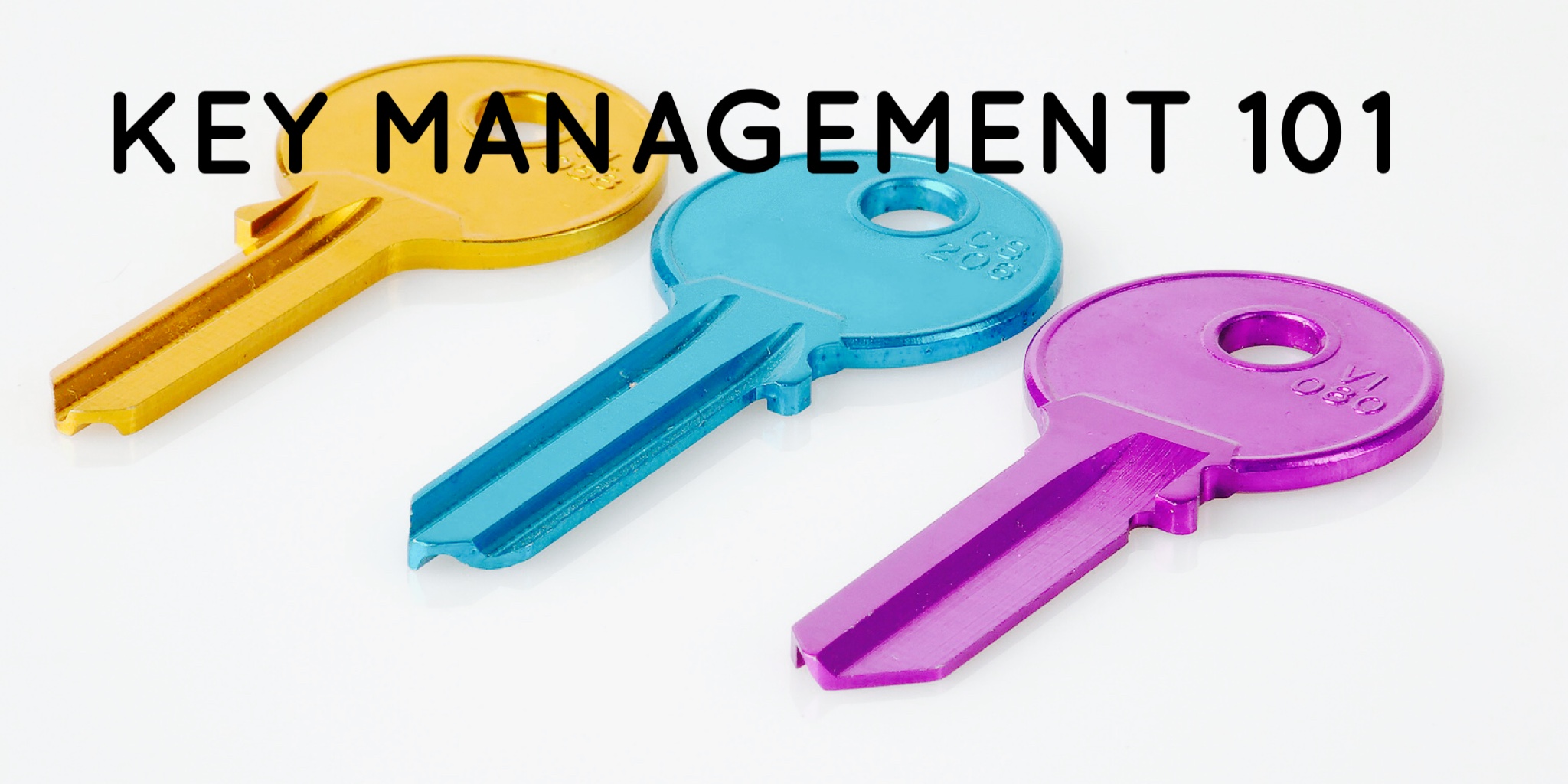
Find a similar article by tags
data security key management Networked Storage Security Threats storage securityWish You Knew More About Storage? Geek Out with SNIA
Feb 18, 2020
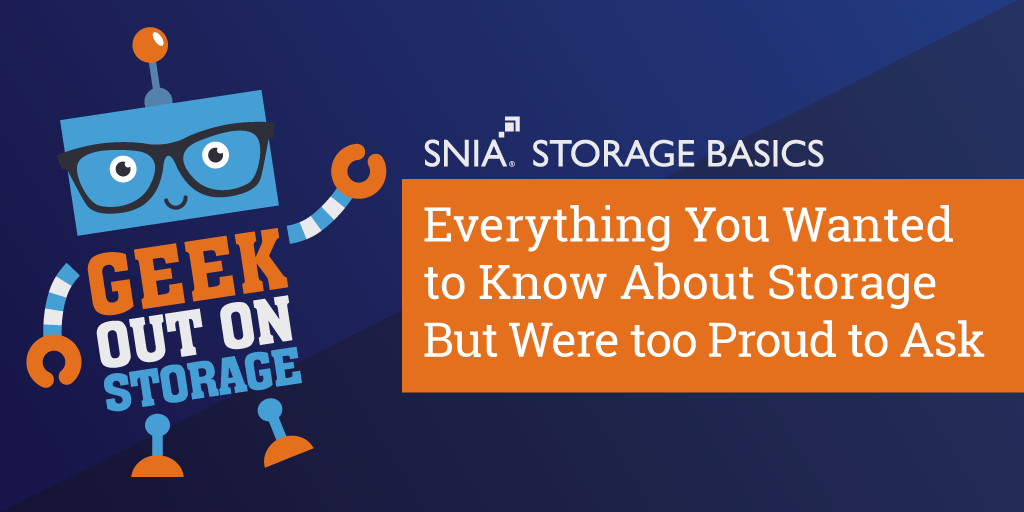
Are you a storage geek at heart? Or perhaps an aspiring one? Here’s your chance to “Geek Out” on all the storage basics. Whether you need a refresh on a foundational storage technology or want a 101 lesson on something new, SNIA has you covered.
Visit our “Geek Out on Storage” page for a unique lesson on storage basics. We call it “Everything You Wanted to Know About Storage But Were Too Proud to Ask.” Here you’ll find videos that clearly define and explain storage terminology and technologies.
You can start by making sure you really understand the basics in our “Naming of the Storage Parts.” Here, our experts break down and clearly define terms like initiators & targets, RAID, controllers, volume managers and storage stacks. Find out what they are and how they really work.
Want to dive deeper? There are 9 more “Everything You Wanted to Know About Storage But Were Too Proud to Ask” videos that offer vendor-neutral education on memory, storage management, architecture, buffers, queues & caches and more. You pick and choose the ones that you want to “Geek Out” on.
While you’re geeking out, you’ll have access to other SNIA educational assets and tools like the SNIA Educational Library which houses more than 2,000 white papers, technical specifications, podcast, presentations and more, the SNIA Online Dictionary that provides succinct definitions on more thatn 1,900 technology terms, our What Is pages and the SNIAVideo YouTube channel.
SNIA is committed to delivering vendor-neutral education to help advance storage and information technology. SNIA members are experts in all things related to storage and come to SNIA to take off their vendor hats to promote standards and education that will enhance the industry as a whole. We hope you find this information valuable and learn something new that elevates your storage geek status!
Leave a Reply
Hyperscalers Take on NVMe™ Cloud Storage Questions
Dec 2, 2019
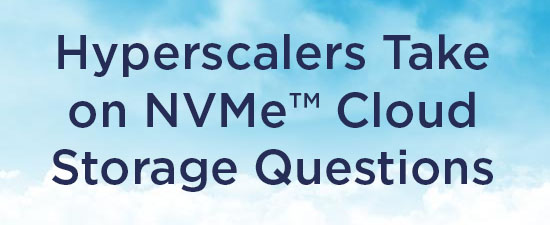
A. Not clear yet if Ethernet is the right connection mechanism for storage disaggregation. CXL is becoming interesting.
Q. Thoughts on E3? What problems are being solved with E3? A. E3 is meant more for 2U servers. Q. ZNS has a lot of QoS implications as we load up so many dies on E1.L FF. Given the challenge how does ZNS address the performance requirements from regular cloud requirements? A. With QLC, the end to end systems need to be designed to meet the application’s requirements. This is not limited to the ZNS device itself, but needs to take into account the entire system. If you’re looking for more resources on any of the topics addressed in this blog, check out the SNIA Educational Library where you’ll find over 2,000 vendor-neutral presentations, white papers, videos, technical specifications, webcasts and more.Find a similar article by tags
Cloud Storage Hyperscalers Networked Storage NVMe Solid State Storage SSDsLeave a Reply
Hyperscalers Take on NVMe™ Cloud Storage Questions
Dec 2, 2019

Our recent webcast on how Hyperscalers, Facebook and Microsoft are working together to merge their SSD drive requirements generated a lot of interesting questions. If you missed "How Facebook & Microsoft Leverage NVMe Cloud Storage" you can watch it on-demand. As promised at our live event. Here are answers to the questions we received.
Q. How does Facebook or Microsoft see Zoned Name Spaces being used?
A. Zoned Name Spaces are how we will consume QLC NAND broadly. The ability to write to the NAND sequentially in large increments that lay out nicely on the media allows for very little write amplification in the device.
Q. How high a priority is firmware malware? Are there automated & remote management methods for detection and fixing at scale?
A. Security in the data center is one of the highest priorities. There are tools to monitor and manage the fleet including firmware checking and updating.
Q. If I understood correctly, the need for NVMe rooted from the need of communicating at faster speeds with different components in the network. Currently, at which speed is NVMe going to see no more benefit with higher speed because of the latencies in individual components? Which component is most gating/concerning at this point?
A. In today's SSDs, the NAND latency dominates. This can be mitigated by adding backend channels to the controller and optimization of data placement across the media. There are applications that are direct connect to the CPU where performance scales very well with PCIe lane speeds and do not have to deal with network latencies.
Q. Where does zipline fit? Does Microsoft expect Azure to default to zipline at both ends of the Azure network?
A. Microsoft has donated the RTL for the Zipline compression ASIC to Open Compute so that multiple endpoints can take advantage of "bump in the wire" inline compression.
Q. What other protocols exist that are competing with NVMe? What are the pros and cons for these to be successful?
A. SATA and SAS are the legacy protocols that NVMe was designed to replace. These protocols still have their place in HDD deployments.
Q. Where do you see U.2 form factor for NVMe?
A. Many enterprise solutions use U.2 in their 2U offerings. Hyperscale servers are mostly focused on 1U server form factors were the compact heights of E1.S and E1.L allow for vertical placement on the front of the server.
Q. Is E1.L form factor too big (32 drives) for failure domain in a single node as a storage target?
A. E1.L allows for very high density storage. The storage application must take into account the possibility of device failure via redundancy (mirroring, erasure coding, etc.) and rapid rebuild. In the future, the ability for the SSD to slowly lose capacity over time will be required.
Q. What has been the biggest pain points in using NVMe SSD - since inception/adoption, especially, since Microsoft and Facebook started using this.
A. As discussed in the live Q&A, in the early days of NVMe the lack of standard drives for both Windows and Linux hampered adoption. This has since been resolved with standard in box drive offerings.
Q. Has FB or Microsoft considered allowing drives to lose data if they lose power on an edge server? if the server is rebuilt on a power down this can reduce SSD costs.
A. There are certainly interesting use cases where Power Loss Protection is not needed.
Q. Do zoned namespaces makes Denali spec obsolete or dropped by Microsoft? How does it impact/compete open channel initiatives by Facebook?
A. Zoned Name Spaces incorporates probably 75% of the Denali functionality in an NVMe standardized way.
Q. How stable is NVMe PCIe hot plug devices (unmanaged hot plug)?
A. Quite stable.
Q. How do you see Ethernet SSDs impacting cloud storage adoption?
A. Not clear yet if Ethernet is the right connection mechanism for storage disaggregation. CXL is becoming interesting.
Q. Thoughts on E3? What problems are being solved with E3?
A. E3 is meant more for 2U servers.
Q. ZNS has a lot of QoS implications as we load up so many dies on E1.L FF. Given the challenge how does ZNS address the performance requirements from regular cloud requirements?
A. With QLC, the end to end systems need to be designed to meet the application's requirements. This is not limited to the ZNS device itself, but needs to take into account the entire system.
If you're looking for more resources on any of the topics addressed in this blog, check out the SNIA Educational Library where you'll find over 2,000 vendor-neutral presentations, white papers, videos, technical specifications, webcasts and more.
Leave a Reply
SPDK in the NVMe-oF™ Landscape
Nov 25, 2019
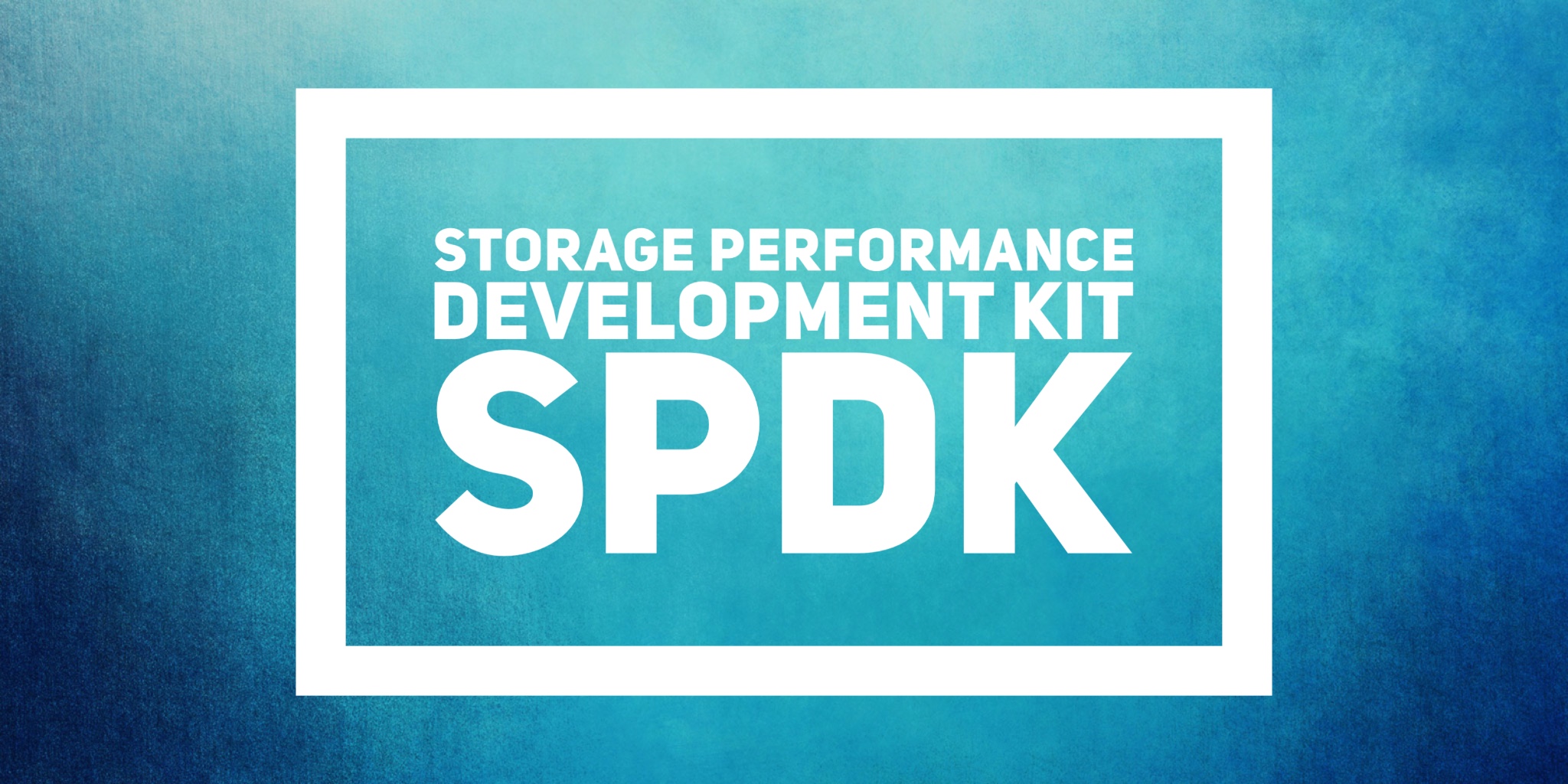
 . This includes software drivers and libraries for building NVMe over Fabrics (NVMe-oF) host and target solutions. On January 9, 2020, the SNIA Networking Storage Forum is going to kick-off its 2020 webcast program by diving into this topic with a live webcast “Where Does SPDK Fit in the NVMe-oF Landscape.”
In this presentation, SNIA members and technical leaders from SPDK, Jim Harris and Ben Walker, will provide an overview of the SPDK project, NVMe-oF use cases that are best suited for SPDK, and insights into how SPDK achieves its storage networking performance and efficiency, discussing:
. This includes software drivers and libraries for building NVMe over Fabrics (NVMe-oF) host and target solutions. On January 9, 2020, the SNIA Networking Storage Forum is going to kick-off its 2020 webcast program by diving into this topic with a live webcast “Where Does SPDK Fit in the NVMe-oF Landscape.”
In this presentation, SNIA members and technical leaders from SPDK, Jim Harris and Ben Walker, will provide an overview of the SPDK project, NVMe-oF use cases that are best suited for SPDK, and insights into how SPDK achieves its storage networking performance and efficiency, discussing:
- An overview of the SPDK project
- Key NVMe-oF use cases for SPDK
- Examples of NVMe-oF use cases not suited for SPDK
- NVMe-oF target architecture and design
- NVMe-oF host architecture and design
- Performance data
Leave a Reply
A Q&A to Better Understand Storage Security
Nov 1, 2019

 Truly understanding storage security issues is no small task, but the SNIA Networking Storage Forum (NSF) is taking that task on in our Storage Networking Security Webcast Series. Earlier this month, we hosted the first in this series, “Understanding Storage Security and Threats” where my SNIA colleagues and I examined the big picture of storage security, relevant terminology and key concepts. If you missed the live event, you can watch it on-demand.
Our audience asked some great questions during the live event. Here are answers to them all.
Q. If I just deploy self-encrypting drives, doesn’t that take care of all my security concerns?
A. No it does not. Self-encrypted drives can protect if the drive gets misplaced or stolen, but they don’t protect if the operating system or application that accesses data on those drives is compromised.
Q. What does “zero trust” mean?
A. “Zero Trust” is a security model that works on the principal that organizations should not automatically trust anything inside their network (typically inside the firewalls). In fact they should not automatically trust any group of users, applications, or servers. Instead, all access should be authenticated and verified. What this typically means is granting the least amount of privileges and access needed based on who is asking for access, the context of the request, and the risk associated.
Q. What does white hat vs. black hat mean?
A. In the world of hackers, a “black hat” is a malicious actor that actually wants to steal your data or compromise your system for their own purposes. A “white hat” is an ethical (or reformed) hacker that attempts to compromise your security systems with your permission, in order to verify its security or find vulnerabilities so you can fix them. There are entire companies and industry groups that make looking for security vulnerabilities a full-time job.
Q. Do I need to hire someone to try to hack into my systems to see if they are secure?
A. To achieve the highest levels of information security, it is often helpful to hire a “white hat” hacker to scan your systems and try to break into them. Some organizations are required–by regulation–to do this periodically to verify the security of their systems. This is sometimes referred to as “penetration testing” or “ethical hacking” and can include physical as well as electronic testing of an infrastructure or even directing suspicious calls and emails to employees to test their security training. All known IT security vulnerabilities are eventually documented and published. You might have your own dedicated security team that regularly tests your operating systems, applications and network for known vulnerabilities and performs penetration testing, or you can hire independent 3rd parties to do this. Some security companies sell tools you can use to test your network and systems for known security vulnerabilities.
Q. Can you go over the difference between authorization and authentication again?
A. Authorization is a mechanism for verifying that a person or application has the authority to perform certain actions or access specific data. Authentication is a mechanism or process for verifying a person is who he or she claims to be. For example, use of passwords, secure tokens/badges, or fingerprint/iris scans upon login (or physical entry) can authenticate who a person is. After login or entry, the use of access control lists, color coded badges, or permissions tables can determine what that person is authorized to do.
Q. Can you explain what non-repudiation means, and how you can implement it?
A. Non-repudiation is a method or technology that guarantees the accuracy or authenticity of information or an action, preventing it from being repudiated (successfully disputed or challenged). For example, a hash could ensure that a retrieved file is authentic, or a combination of biometric authentication with an audit log could prove that a particular person was the one who logged into a system or accessed a file.
Q. Why would an attacker want to infiltrate data into a data center, as opposed to exfiltrating (stealing) data out of the data center?
A. Usually malicious actors (hackers) want to exfiltrate (remove) valuable data. But sometimes they want to infiltrate (insert) malware into the target’s data center so this malware can carry out other attacks.
Q. What is ransomware, and how does it work?
A. Ransomware typically encrypts, hides or blocks access to an organization’s critical data, then the malicious actor who sent it demands payment or action from the organization in return for sharing the password that will unlock the ransomed data.
Q. Can you suggest some ways to track and report attacking resources?
A. Continuous monitoring tools such as Splunk can be used.
Q. Does “trust nobody” mean, don’t trust root/admin user as well?
A. Trust nobody means there should be no presumption of trust, instead we should authenticate and authorize all users/requests. For example, it could mean changing the default root/admin password, requiring most administrative work to use specific accounts (instead of the root/admin account), and monitoring all users (including root/admin) to detect inappropriate behavior.
Q. How do I determine my greatest vulnerability or the weakest link in my security?
A. Activities such as Threat Models and Security Assessments can assist in determining weakest links.
Q. What does a ‘trust boundary’ mean?
A. Trust boundary is a boundary where program data or execution changes its level of “trust”. For example, Internet vs intranet.
We are busy planning out the rest of this webcast series. Please follow us Twitter @SNIANSF for notifications of dates and times for each presentation.
Truly understanding storage security issues is no small task, but the SNIA Networking Storage Forum (NSF) is taking that task on in our Storage Networking Security Webcast Series. Earlier this month, we hosted the first in this series, “Understanding Storage Security and Threats” where my SNIA colleagues and I examined the big picture of storage security, relevant terminology and key concepts. If you missed the live event, you can watch it on-demand.
Our audience asked some great questions during the live event. Here are answers to them all.
Q. If I just deploy self-encrypting drives, doesn’t that take care of all my security concerns?
A. No it does not. Self-encrypted drives can protect if the drive gets misplaced or stolen, but they don’t protect if the operating system or application that accesses data on those drives is compromised.
Q. What does “zero trust” mean?
A. “Zero Trust” is a security model that works on the principal that organizations should not automatically trust anything inside their network (typically inside the firewalls). In fact they should not automatically trust any group of users, applications, or servers. Instead, all access should be authenticated and verified. What this typically means is granting the least amount of privileges and access needed based on who is asking for access, the context of the request, and the risk associated.
Q. What does white hat vs. black hat mean?
A. In the world of hackers, a “black hat” is a malicious actor that actually wants to steal your data or compromise your system for their own purposes. A “white hat” is an ethical (or reformed) hacker that attempts to compromise your security systems with your permission, in order to verify its security or find vulnerabilities so you can fix them. There are entire companies and industry groups that make looking for security vulnerabilities a full-time job.
Q. Do I need to hire someone to try to hack into my systems to see if they are secure?
A. To achieve the highest levels of information security, it is often helpful to hire a “white hat” hacker to scan your systems and try to break into them. Some organizations are required–by regulation–to do this periodically to verify the security of their systems. This is sometimes referred to as “penetration testing” or “ethical hacking” and can include physical as well as electronic testing of an infrastructure or even directing suspicious calls and emails to employees to test their security training. All known IT security vulnerabilities are eventually documented and published. You might have your own dedicated security team that regularly tests your operating systems, applications and network for known vulnerabilities and performs penetration testing, or you can hire independent 3rd parties to do this. Some security companies sell tools you can use to test your network and systems for known security vulnerabilities.
Q. Can you go over the difference between authorization and authentication again?
A. Authorization is a mechanism for verifying that a person or application has the authority to perform certain actions or access specific data. Authentication is a mechanism or process for verifying a person is who he or she claims to be. For example, use of passwords, secure tokens/badges, or fingerprint/iris scans upon login (or physical entry) can authenticate who a person is. After login or entry, the use of access control lists, color coded badges, or permissions tables can determine what that person is authorized to do.
Q. Can you explain what non-repudiation means, and how you can implement it?
A. Non-repudiation is a method or technology that guarantees the accuracy or authenticity of information or an action, preventing it from being repudiated (successfully disputed or challenged). For example, a hash could ensure that a retrieved file is authentic, or a combination of biometric authentication with an audit log could prove that a particular person was the one who logged into a system or accessed a file.
Q. Why would an attacker want to infiltrate data into a data center, as opposed to exfiltrating (stealing) data out of the data center?
A. Usually malicious actors (hackers) want to exfiltrate (remove) valuable data. But sometimes they want to infiltrate (insert) malware into the target’s data center so this malware can carry out other attacks.
Q. What is ransomware, and how does it work?
A. Ransomware typically encrypts, hides or blocks access to an organization’s critical data, then the malicious actor who sent it demands payment or action from the organization in return for sharing the password that will unlock the ransomed data.
Q. Can you suggest some ways to track and report attacking resources?
A. Continuous monitoring tools such as Splunk can be used.
Q. Does “trust nobody” mean, don’t trust root/admin user as well?
A. Trust nobody means there should be no presumption of trust, instead we should authenticate and authorize all users/requests. For example, it could mean changing the default root/admin password, requiring most administrative work to use specific accounts (instead of the root/admin account), and monitoring all users (including root/admin) to detect inappropriate behavior.
Q. How do I determine my greatest vulnerability or the weakest link in my security?
A. Activities such as Threat Models and Security Assessments can assist in determining weakest links.
Q. What does a ‘trust boundary’ mean?
A. Trust boundary is a boundary where program data or execution changes its level of “trust”. For example, Internet vs intranet.
We are busy planning out the rest of this webcast series. Please follow us Twitter @SNIANSF for notifications of dates and times for each presentation.
Leave a Reply
Software Defined Storage Q&A
Oct 25, 2019

Find a similar article by tags
Networked StorageLeave a Reply
Software Defined Storage Q&A
Oct 25, 2019

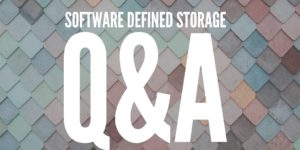 The SNIA Networking Storage Forum (NSF) recently hosted a live webcast, What Software Defined Storage Means for Storage Networking where our experts, Ted Vojnovich and Fred Bower explained what makes software defined storage (SDS) different from traditional storage. If you missed the live event, you can watch it on-demand at your convenience. We had several questions at the live event and here are our experts’ answers to them all:
Q. Are there cases where SDS can still work with legacy storage so that high priority flows, online transaction processing (OLTP) can use SAN for the legacy storage while not so high priority and backup data flows utilize the SDS infrastructure?
A. The simple answer is, yes. Like anything else, companies are using different methods and architectures to resolve their compute and storage requirements. Just like public cloud may be used for some non-sensitive/vital data and in-house cloud or traditional storage for sensitive data. Of course, this adds costs, so benefits need to be weighed against the additional expense.
Q. What is the best way to mitigate unpredictable network latency that can go out of the bounds of a storage required service level agreement (SLA)?
A. There are several ways to mitigate latency. Generally speaking, increased bandwidth contributes to better network speed because the “pipe” is essentially larger and more data can travel through it. There are other means as well to reduce latency such the use of offloads and accelerators. Remote Direct Memory Access (RDMA) is one of these and is being used by many storage companies to help handle the increased capacity and bandwidth needed in Flash storage environments. Edge computing should also be added to this list as it relocated key data processing and access points from the center of the network to the edge where it can be gathered and delivered more efficiently.
Q. Can you please elaborate on SDS scaling in comparison with traditional storage?
A. Most SDS solutions are designed to scale-out both performance and capacity to avoid bottlenecks whereas most traditional storage has always had limited scalability, scaling up in capacity only. This is because as a scale-up storage system begins to reach capacity, the controller becomes saturated and performance suffers. The workaround for this problem with traditional storage is to upgrade the storage controller or purchase more arrays, which can often lead to unproductive and hard to manage silos.
Q. You didn’t talk much about distributed storage management and namespaces (i.e. NFS or AFS)?
A. Storage management consists of monitoring and maintaining storage health, platform health, and drive health. It also includes storage provisioning such as creating each LUN /share/etc., or binding LUNs to controllers and servers. On top of that, storage management involves storage services like disk groups, snapshot, dedupe, replication, etc. This is true for both SDS and traditional storage (Converged Infrastructure and Hyper-Converged Infrastructure will leverage this ability in storage). NFS is predominately a non-Windows (Linux, Unix, VMware) file storage protocol while AFS is no longer popular in the data center and has been replaced as a file storage protocol by either NFS or SMB (in fact, it’s been a long time since somebody mentioned “AFS”).
Q. How does SDS affect storage networking? Are SAN vendors going to lose customers?
A. SAN vendors aren’t going anywhere because of the large existing installed base which isn’t going quietly into the night. Most SDS solutions focus on Ethernet connectivity (as diagrams state) while traditional storage is split between Fibre Channel and Ethernet; InfiniBand is more of a niche storage play for HPC and some AI or machine learning customers.
Q. Storage costs for SDS are highly dependent on scale and replication or erasure code. An erasure coded multi-petabyte solution can be significantly less than a traditional storage solution.
A. It’s a processing complexity vs. cost of additional space tradeoff. Erasure coding is processing intense but requires less storage capacity. Making copies uses less processing power but consumes more capacity. It is true to say replicating copies uses more network bandwidth. Erasure coding tends to be used more often for storage of large objects or files, and less often for latency-sensitive block storage.
If you have more questions on SDS, let us know in the comment box.
The SNIA Networking Storage Forum (NSF) recently hosted a live webcast, What Software Defined Storage Means for Storage Networking where our experts, Ted Vojnovich and Fred Bower explained what makes software defined storage (SDS) different from traditional storage. If you missed the live event, you can watch it on-demand at your convenience. We had several questions at the live event and here are our experts’ answers to them all:
Q. Are there cases where SDS can still work with legacy storage so that high priority flows, online transaction processing (OLTP) can use SAN for the legacy storage while not so high priority and backup data flows utilize the SDS infrastructure?
A. The simple answer is, yes. Like anything else, companies are using different methods and architectures to resolve their compute and storage requirements. Just like public cloud may be used for some non-sensitive/vital data and in-house cloud or traditional storage for sensitive data. Of course, this adds costs, so benefits need to be weighed against the additional expense.
Q. What is the best way to mitigate unpredictable network latency that can go out of the bounds of a storage required service level agreement (SLA)?
A. There are several ways to mitigate latency. Generally speaking, increased bandwidth contributes to better network speed because the “pipe” is essentially larger and more data can travel through it. There are other means as well to reduce latency such the use of offloads and accelerators. Remote Direct Memory Access (RDMA) is one of these and is being used by many storage companies to help handle the increased capacity and bandwidth needed in Flash storage environments. Edge computing should also be added to this list as it relocated key data processing and access points from the center of the network to the edge where it can be gathered and delivered more efficiently.
Q. Can you please elaborate on SDS scaling in comparison with traditional storage?
A. Most SDS solutions are designed to scale-out both performance and capacity to avoid bottlenecks whereas most traditional storage has always had limited scalability, scaling up in capacity only. This is because as a scale-up storage system begins to reach capacity, the controller becomes saturated and performance suffers. The workaround for this problem with traditional storage is to upgrade the storage controller or purchase more arrays, which can often lead to unproductive and hard to manage silos.
Q. You didn’t talk much about distributed storage management and namespaces (i.e. NFS or AFS)?
A. Storage management consists of monitoring and maintaining storage health, platform health, and drive health. It also includes storage provisioning such as creating each LUN /share/etc., or binding LUNs to controllers and servers. On top of that, storage management involves storage services like disk groups, snapshot, dedupe, replication, etc. This is true for both SDS and traditional storage (Converged Infrastructure and Hyper-Converged Infrastructure will leverage this ability in storage). NFS is predominately a non-Windows (Linux, Unix, VMware) file storage protocol while AFS is no longer popular in the data center and has been replaced as a file storage protocol by either NFS or SMB (in fact, it’s been a long time since somebody mentioned “AFS”).
Q. How does SDS affect storage networking? Are SAN vendors going to lose customers?
A. SAN vendors aren’t going anywhere because of the large existing installed base which isn’t going quietly into the night. Most SDS solutions focus on Ethernet connectivity (as diagrams state) while traditional storage is split between Fibre Channel and Ethernet; InfiniBand is more of a niche storage play for HPC and some AI or machine learning customers.
Q. Storage costs for SDS are highly dependent on scale and replication or erasure code. An erasure coded multi-petabyte solution can be significantly less than a traditional storage solution.
A. It’s a processing complexity vs. cost of additional space tradeoff. Erasure coding is processing intense but requires less storage capacity. Making copies uses less processing power but consumes more capacity. It is true to say replicating copies uses more network bandwidth. Erasure coding tends to be used more often for storage of large objects or files, and less often for latency-sensitive block storage.
If you have more questions on SDS, let us know in the comment box.
Leave a Reply
How Facebook & Microsoft Leverage NVMe™ Cloud Storage
Oct 9, 2019

- IOPs requirements for Hyperscalers
- Challenges when managing at scale
- Issues around form factors
- Need to allow for "rot in place"
- Remote debugging requirements
- Security needs
- Deployment success factors
Leave a Reply
How Facebook & Microsoft Leverage NVMe Cloud Storage
Oct 9, 2019

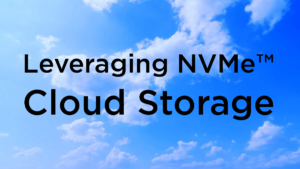 What do Hyperscalers like Facebook and Microsoft have in common? Find out in our next SNIA Networking Storage Forum (NSF) webcast, How Facebook and Microsoft Leverage NVMe Cloud Storage, on November 19, 2019 where you’ll hear how these cloud market leaders are using NVMe SSDs in their architectures.
Our expert presenters, Ross Stenfort, Hardware System Engineer at Facebook and Lee Prewitt, Principal Hardware Program Manager, Azure CSI at Microsoft, will provide a close up look into their application requirements and challenges, why they chose NVMe flash for storage, and how they are successfully deploying NVMe to fuel their businesses. You’ll learn:
What do Hyperscalers like Facebook and Microsoft have in common? Find out in our next SNIA Networking Storage Forum (NSF) webcast, How Facebook and Microsoft Leverage NVMe Cloud Storage, on November 19, 2019 where you’ll hear how these cloud market leaders are using NVMe SSDs in their architectures.
Our expert presenters, Ross Stenfort, Hardware System Engineer at Facebook and Lee Prewitt, Principal Hardware Program Manager, Azure CSI at Microsoft, will provide a close up look into their application requirements and challenges, why they chose NVMe flash for storage, and how they are successfully deploying NVMe to fuel their businesses. You’ll learn:
- IOPs requirements for Hyperscalers
- Challenges when managing at scale
- Issues around form factors
- Need to allow for “rot in place”
- Remote debugging requirements
- Security needs
- Deployment success factors







Leave a Reply